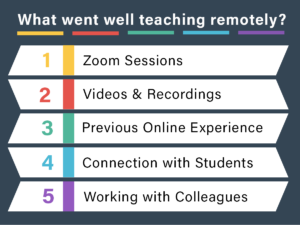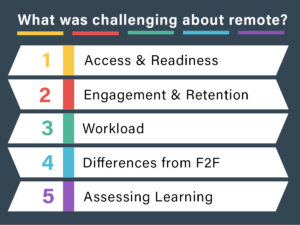By Kaitlin Lucas, Heather Mariger, and Bill Hamlin
At the end of spring term, the Center for Academic Innovation (CAI) sent out a blast survey to Chemeketa faculty to capture information about your experience moving to remote teaching. We appreciate the time you took to share your thoughts with us – your insights will help us prepare useful resources for a remote fall term.
From a technical standpoint, the survey showed that synchronous Zoom sessions were the most successful element of your courses. Some faculty ran Zoom sessions during regular class time, while others hosted optional virtual office hours and Q&A sessions. Breakout rooms and whiteboards helped to make Zoom classes interactive.
 Students also found videos and recordings to be useful in the remote format. Breaking lectures into smaller chunks allowed students to complete coursework at their convenience, especially as their schedules may have been upended by the pandemic.
Students also found videos and recordings to be useful in the remote format. Breaking lectures into smaller chunks allowed students to complete coursework at their convenience, especially as their schedules may have been upended by the pandemic.
Those of you who have taught online before discussed how your previous experience aided you with the switch to remote. This is good news as your experiences this spring will help you as we move into summer and fall.
Finally, you noted the importance of the human aspect of remote teaching. Respondents reported increased communication and cooperation between colleagues. Likewise, communication and connection with students was cited as one of the most positive aspects of remote teaching. Whether you connected through Zoom, Blackboard, texting or chat, that connection helped both faculty and students feel less isolated and more united during a very uncertain time.
On the other hand, you shared that technological access and readiness were two of the greatest challenges this spring. Not only did some students have to learn how to use new technologies at the same time they were learning course content, but some also did not have consistent access to the devices and services needed to participate. Many instructors also faced the challenge of not having the equipment necessary to complete certain tasks, such as recording videos or calling students.
 It was also difficult to sustain student engagement throughout the term. Undoubtedly, you and your students experienced additional challenges outside of academics. Many students had additional family responsibilities and work challenges, making it difficult for them to engage in their coursework. Many of you also reported that some students who normally would not enroll in online courses were overwhelmed with the sudden transition to remote learning.
It was also difficult to sustain student engagement throughout the term. Undoubtedly, you and your students experienced additional challenges outside of academics. Many students had additional family responsibilities and work challenges, making it difficult for them to engage in their coursework. Many of you also reported that some students who normally would not enroll in online courses were overwhelmed with the sudden transition to remote learning.
Another challenge was replicating your face-to-face classes in a remote modality. As one respondent shared, it’s just not the same as being in a classroom with students. Hands-on activities, labs, and community-based projects had to be rethought in a matter of weeks. You also expressed difficulty assessing how much students were learning behind the screen.
Ultimately, you shared that you are exhausted after a remote spring term. So many of you went above and beyond to provide a quality remote experience for students, despite the extra workload and all of the ways that your own lives were affected by the pandemic. As your colleagues, we at the CAI cannot thank you enough for everything that you have done to support students and each other, and we hope that you have time over the summer to recharge and spend some time screen-free.
